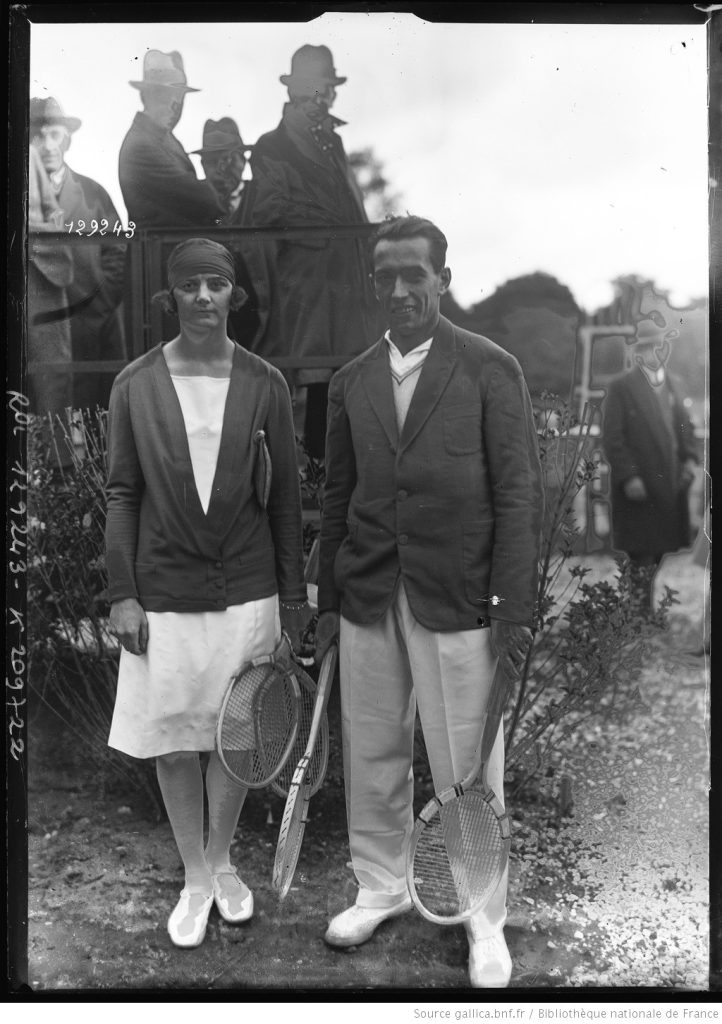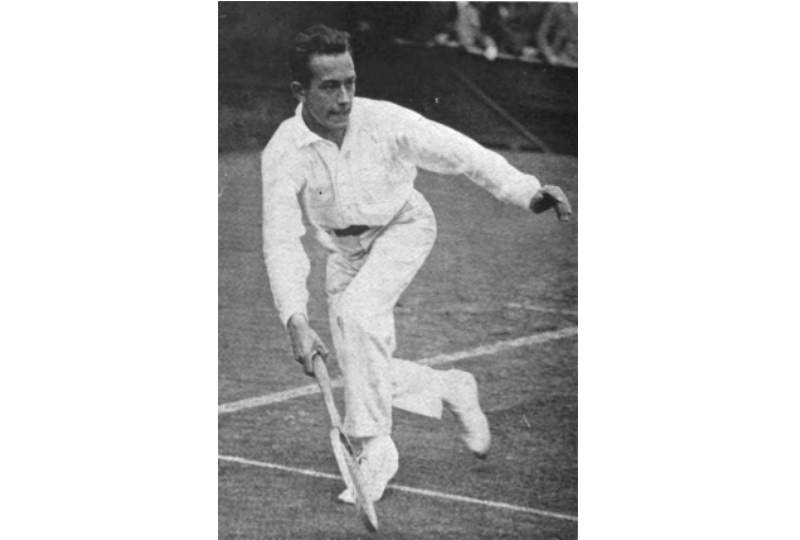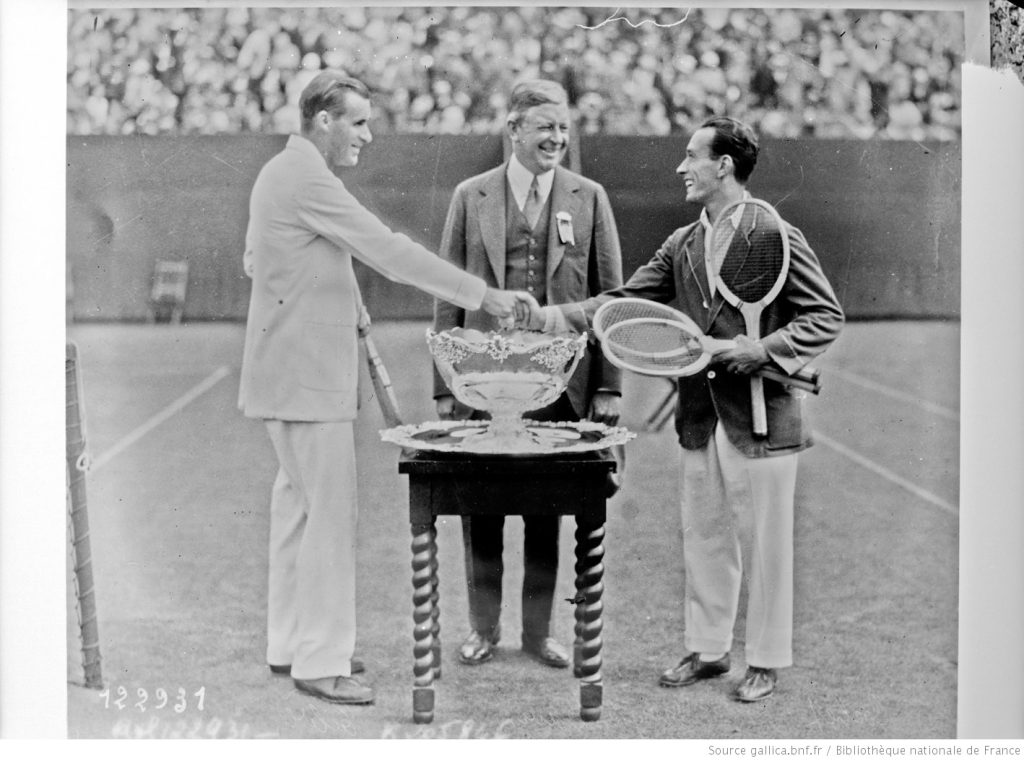In 2022, I’m counting down the 128 best players of the last century. With luck, we’ll get to #1 in December. Enjoy!
* * *
Henri Cochet [FRA]Born: 14 December 1901
Died: 1 April 1987
Career: 1920-51
Plays: Right-handed (one-handed backhand)
Peak rank: 1 (1928)
Major singles titles: 7*
Total singles titles: 101
* Plus the 1922 French Championships, which were not yet open to foreigners, and the 1922 World Hard Courts, which are considered by some to have been a major.
* * *
Down two sets to love, most players begin to recognize it’s just not their day. They might try some new tactics or look for signs that their opponent is tiring. But no matter what optimism they can muster, the odds are stacked in the other direction. In the amateur era, front-runners converted two-set leads even more often than they do now.
Henri Cochet was not “most players.” He was “an enfant terrible who love[d] to play with fire,” in the words of John Tunis. In the New Yorker ahead of the 1928 US National Championships, Tunis wrote:
[H]e is never in his real element until the tactical situation forces him to admit the possibility of defeat…. [W]ith the score two sets and four games to one against him, he becomes tight-lipped and firm, brilliant and audacious, careful and scintillating all at once. Those are the moments when his shots are so uncanny, so unorthodox, so impossible that they seem almost insolent.
We can read between the lines and deduce that at the beginning of a match, the Frenchman was not particularly brilliant or careful. His Davis Cup teammate Jean Borotra was known for steamrolling through the first two sets, then tanking the third–and sometimes the fourth–to save energy for a final push. Cochet didn’t lose the first two sets on purpose, but it sometimes looked that way. The newspapers dubbed him “Five-Set Cochet,” and Tunis’s New Yorker profile was titled “Lucky Cochet.”
But unless we’re talking about the unpredictability of his mood, luck had nothing to do with it. René Lacoste said, “At his best, Cochet is unquestionably the best singles player in the world today.” Suzanne Lenglen agreed: “On a good day, nobody in the world can stop him.”
Bill Tilden went even one step further: “In these inspired moments of his, Cochet is the greatest of all Frenchmen, and in my opinion, possibly the greatest player who has ever lived.” At various times, Tilden called him a “genius” and a “revolutionary.” Most flattering of all, the American considered Cochet to be his nemesis, the only amateur against whom he lost more often than he won.
* * *
It was a great era for nicknames. Lacoste, the diffident baseliner, was The Crocodile. Borotra, the serve-and-volleyer from the Pyrenees, was The Bounding Basque. Cochet, the all-court player with every shot in his arsenal, was The Magician. Together with Jacques “Toto” Brugnon, they were the Four Musketeers, France’s greatest tennis generation.
Before Cochet became The Magician, he was The Ballboy of Lyon. Unlike most of his contemporaries on the international tennis circuit, Henri came from working-class stock. Fortunately, his father earned his paycheck at a tennis club, first as groundskeeper, then as manager. The youngster earned pocket money chasing down stray balls, and when he could borrow a racket, he would hit with anyone willing to play with him.
The Lyonnaise club offered one particularly useful perk: a pair of covered courts. Indoor tennis was typically played on wooden boards, a surface that was quicker than outdoor clay, and one that offered a truer, more consistent bounce than grass or crushed brick. Cochet could practice year-round, and the indoor boards forced him to learn to meet the ball on the rise and half-volley with ease.
Cochet would later earn the reputation of a player who avoided hard training, but he took full advantage of his father’s occupation. He believed that there was no better way to develop strokes than to practice against a wall. The game that eventually made him the best in the world pointed straight back to all those long hours on covered courts in Lyon.
Cochet at Wimbledon in 1925
The resulting all-court game is what led Tilden to call him a revolutionary. Most players of his time were either baseliners (like Lacoste) or serve-and-volleyers (like Borotra). Plenty of men were able to do both–most notably Tilden himself–but before Cochet, no one had fully integrated a baseline game with the ability to attack at any moment. The Magician was unfazed by the threat of a ball at his feet, so he habitually took a more aggressive position than his peers. And unlike anyone else of his time, he could move in smoothly behind a half-volley.
Cochet’s unorthodox positioning didn’t stop there. He stood only five-feet-six-inches tall, so playing too close to the net just invited a lob. (Tilden, for one, was an expert lobber.) While his height left him with an indifferent serve, he was a master of the overhead smash. The smash, combined with his readiness to hit low volleys and half-volleys, meant he didn’t need to crowd the net. The Ballboy of Lyon knew how to beat you from anywhere, and when he was in the mood, he did just that.
* * *
One theory of why Cochet was so inconsistent, not just from match to match but from set to set, is that he was more temperamental than he looked and was sometimes too nervous to effectively wield his world-class weapons. The alternate theory is that he was so confident that he trusted he could always recover from a patch of bad play.
We’ll never know for sure, but the evidence points strongly in the direction of extreme confidence, self-assurance bordering on the obnoxious.
In the 1926 Davis Cup Inter-Zonal final, France took on Japan for the opportunity to challenge the defending champion United States. The Musketeers increasingly looked like they would threaten America’s dominance of the Cup: Cochet was the reigning French champion, and Borotra had just won Wimbledon. Japan had a strong side but was nowhere near the same level. Still, Cochet needed five sets to get past Tsumio Tawara, and he lost a dead rubber to Takeichi Harada in four. This was not the sort of play that would send the Davis Cup back across the Atlantic.

With the Challenge Round against the US just a few days away, Cochet admitted he was disappointed, but not discouraged. He told Tunis, “Wait until next week. I’m getting better all the time.”
The French captain wasn’t entirely assured, so Lacoste and Borotra handled singles duties. France fell to Tilden and the Americans, four rubbers to one. But at Forest Hills the following week, the Four Musketeers all reached the quarter-finals. Three of them–all but Brugnon–beat their American opponents, and it was Cochet who toppled the great Tilden. The American press dubbed it “Black Thursday.” Bill hadn’t lost a match at his national championship tournament in six years, but the little man from Lyon edged past him, 8-6 in the fifth.
Tilden served for the match at 6-5 in the decider. He showed some signs of fatigue–after all, he was 33 years old, nine years older than his opponent–and his cannonball serve wasn’t quite coming across at full speed. Cochet took the most aggressive return position he could. He didn’t just break serve at love, he won the game with four clean return winners.
Didi Vlasto, a frequent mixed doubles partner of Cochet’s, once said, “Pour Henri c’est toujours l’impossible qui est plus facile”–For Henri, it is always the impossible which is easiest.
* * *
The Magician lost to Lacoste in the Forest Hill semi-finals. The Crocodile won the title–the first ever US champion from a non-English-speaking country–but the failure to capture the Davis Cup still rankled. When the French team left Paris to try again in 1927, Cochet said, “First the Davis Cup and the American Championship. We bring them both back this time, yes?”
By now, his confidence was fully warranted.
Cochet had just won Wimbledon, his first major title outside of France. He had never lacked for self-belief, but the way he took the All-England Club title must have convinced him that he could do absolutely anything.
Cochet at Wimbledon in 1927. A reporter once asked him to explain his serve technique. “The service? Ah, yes. I throw the ball up–and then I hit it.”
In the quarter-finals, Cochet faced the American Frank Hunter. Hunter had reached the Wimbledon final in 1923, and he would come within a set of winning the Forest Hills title in both 1928 and 1929. The American took a comfortable 6-3, 6-3 lead before Cochet woke up and charged back. The Magician won in five, finishing the job 6-2, 6-2, 6-3.
Waiting in the semi-final round was Bill Tilden. Tilden remembered well what happened at Forest Hills the previous year, and he had watched Cochet erase Hunter’s early lead. He was “not going to let that little fellow get me into a long match,” so he would attack from the first ball.
It almost worked. Big Bill won the first two sets, 6-2, 6-4, and built a 5-1 lead in the third. Sportswriter Al Laney was there, and even 40 years later, he wrote, “I can still speak of it in detail … but I could not explain it then and I cannot now.” From 15-all, Tilden started missing, and Cochet’s magic wand sprung to life. Henri won 17 points in a row, and he seized the third set, 7-5. Wimbledon referee F.R. Burrow said that the crowd was “almost too spellbound to applaud.” Cochet completed the comeback, 6-3, 6-4.
Tilden’s exit ensured that the Wimbledon crown would go to a Frenchman for the fourth consecutive year, as Cochet would face Borotra in the final. Inevitably, the front-running Borotra took a two-set lead over the slow-starting Cochet. In ten previous meetings, Jean had grabbed the first two sets twice. Once, at the 1922 World Covered Court Championships, Cochet made his comeback. And once, at the 1924 French Covered Courts, Borotra had held him off.
With Borotra resting, the Magician took the third and fourth sets to even the score. The Basque bounded to a 5-2 lead in the final set, but he couldn’t convert match point. Cochet ultimately saved six match balls, including one when many onlookers (and Borotra) believed that Henri double-hit a volley. The umpire didn’t call it, and Cochet admitted nothing. The Ballboy of Lyon completed his comeback–a second-straight victory from the brink of defeat.
* * *
Cochet’s faith in himself–and his fellow Musketeers–was well-placed. In the 1927 Davis Cup campaign, there were none of the Davis Cup missteps that had made Henri look beatable against Japan the previous year. He straight-setted Einer Ulrich* of Denmark and Yoshiro Ota of Japan to help put his side back in the Challenge Round.
* Father of Davis Cup player Torben, and grandfather to Metallica drummer Lars.
This time, Cochet couldn’t beat Tilden, losing the second rubber in four sets. But his effort was good enough for his team to win. The Musketeers recognized that they needed to take at least one match from Big Bill, so they aimed to collectively wear him out. Cochet worked him hard in his opening singles, and the duo of Borotra and Brugnon kept him running in a five-set doubles rubber the next day. The Frenchmen went into the final day of play down 2-1, but Lacoste beat the exhausted Tilden, and Cochet secured the Cup with a four-set defeat of Bill Johnston.
Lacoste defeated Tilden again in the Forest Hills final, and France’s domination of world tennis was unquestioned. In 1928, Borotra would go to Australia and win the national title there, ensuring that the Muskteers would win seven straight majors between the 1927 French and the 1928 US Championships. They would retain the Davis Cup until Great Britain snatched it away in 1933.
Cochet was an increasingly large part of that success. He won the French and US titles in 1928 and ended the season ranked number one–a position he would hold for four years. He was nearly unbeatable in Davis Cup play in that span, winning both of his singles rubbers every year from 1928 to 1931 and falling short in only one doubles match. He wouldn’t lose a live singles rubber until Fred Perry bested him in a five-setter in 1933.
* * *
With Lacoste retiring due to ill-health and Borotra’s star fading with age, Cochet became the face of French tennis. He won Wimbledon again in 1929, and he added two more French titles to his tally in 1930 and 1932. His sporting goods retailer, Cochet Sports, grew from a tiny shop in Paris to a national chain with outlets in Cannes, Lyon, and La Baule.
For all of Cochet’s nonchalance and dislike of practice, he sure chose to spend a lot of his time on the tennis court. In 1932, he lost in the second round at Wimbledon, only three years removed from his last title there. Tournament organizers were shocked when he turned up to put his name down for the consolation event–which he went on to win. He would keep playing, picking up the occasional title, for another two decades.
In 1933, he turned pro, accepting an offer from Tilden for £25,000 per year. As a professional, he played exhibitions all over the world and coached everyone from the Hungarian Davis Cup team to a group of promising youngsters in the Soviet Union. The Russian adventure proved to be a bit rockier than the usual gig. His hosts accused him of espionage and kicked him out amid the purge of foreign influence in 1938.
World War II halted professional tennis in Europe, and the Magician was eventually reinstated as an amateur. He continued playing competitively under the German occupation, and when his country was freed, he featured in the Liberation Match (umpired by Simonne Mathieu) at Roland Garros–a stadium originally built for the Musketeers’ defense of the Davis Cup in 1928.
Cochet won his last title in 1949, at the age of 48, at the Barcelona International Christmas event. He beat the Australian Jack Harper, 13 years his junior. The same year, he played his last competitive match against friend, foe, and teammate Jean Borotra. Borotra raced to a one-set lead, and Henri found his form to win the second. Cochet lost his momentum and the match, but it’s only fitting that the final clash between the Magician and the Bounding Basque, like the Wimbledon final in 1927, went the distance.

